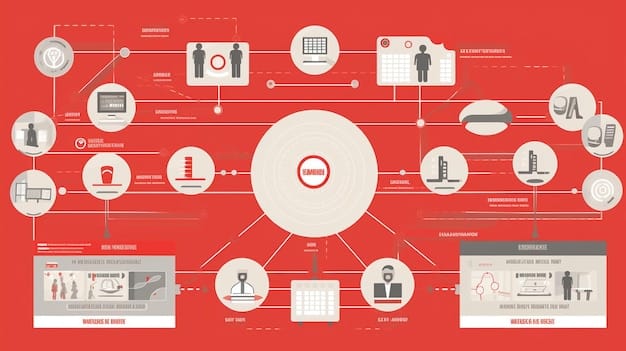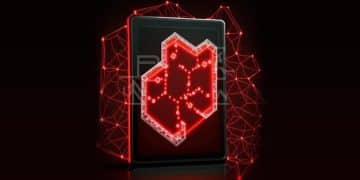Insider Threats: Identify & Mitigate Internal Risk in Organizations

Proactively identifying and mitigating insider threats involves understanding behavioral patterns, implementing robust technical controls, and fostering a culture of cybersecurity awareness to protect an organization’s critical assets from internal compromise.
In the complex landscape of cybersecurity, a significant challenge often overlooked lies within an organization’s own walls: insider threats. These risks, stemming from current or former employees, contractors, or business partners, can manifest in various forms, from data theft to sabotage, making their identification and mitigation paramount for any robust security posture.
Understanding the Diverse Faces of Insider Threats
Insider threats are not monolithic; they encompass a wide spectrum of motivations and methods, making them particularly insidious. While the media often highlights malicious actors, a significant portion of insider incidents are unintentional, a result of negligence, errors, or susceptibility to social engineering. Recognizing these nuances is crucial for developing effective countermeasures.
Malicious insiders intentionally seek to cause harm or gain unauthorized access. Their motivations can range from financial gain, revenge against an employer, or even espionage driven by external entities. These individuals often possess a deep understanding of organizational systems and vulnerabilities, making them highly dangerous.
Types of Malicious Insiders
- Theft of Intellectual Property: Insiders leveraging their access to siphon off patents, trade secrets, or customer data for sale or competitive advantage.
- Sabotage: Deliberate disruption of systems, data deletion, or infrastructure damage motivated by personal vendettas or ideological reasons.
- Espionage: Acting on behalf of an external entity (e.g., foreign government, competitor) to exfiltrate sensitive information.
On the other hand, negligent insiders pose a risk unwittingly. These individuals might fall for phishing scams, misconfigure systems due to lack of training, or simply disregard security protocols for convenience. While not intentionally malicious, the impact of their actions can be just as severe as a targeted attack.
Common Causes of Negligent Insider Incidents
- Phishing and Social Engineering: Employees unknowingly providing credentials or access to malicious third parties.
- Lack of Awareness: Insufficient training on cybersecurity best practices leading to poor judgment.
- Shadow IT: Unauthorized use of applications or services that bypass security controls, creating new vulnerabilities.
A third category, often overlooked, involves the “compromised insider.” In these cases, an employee’s credentials or device are compromised externally, turning them into an unwitting conduit for an attack. This highlights the importance of traditional cybersecurity defenses, even when focusing on internal threats.
Understanding these different facets of insider threats allows organizations to tailor their defense strategies. A purely technical solution might catch malicious activity but fail to address the underlying human factors contributing to negligence, while an awareness program alone might not deter a determined, malicious actor. A holistic approach that integrates technical controls, robust policies, and ongoing education is indispensable.
Behavioral Indicators: Spotting the Red Flags
Identifying potential insider threats requires keen observation of behavioral patterns, coupled with technical monitoring. While no single indicator is definitive, a combination of suspicious behaviors can signal a heightened risk. Organizations must empower their human resources, legal, and security teams to recognize these signs while respecting employee privacy and avoiding unwarranted suspicion.
One key area to monitor is changes in an employee’s work habits or access patterns. This could include accessing data outside of normal business hours, attempting to access systems or information outside their authorized scope, or unusual data downloads or transfers. These actions, especially if they deviate significantly from an employee’s typical routine, warrant further investigation.
Work-Related Behavioral Indicators
- Sudden increase in after-hours access: Logins or data access at unusual times, especially if not typical for their role.
- Access to unrelated systems or files: Employees attempting to access information or areas not required for their job function.
- High volume of data downloads/transfers: Exceeding normal data thresholds, particularly to personal devices or cloud storage.
Beyond digital footprints, personal and professional behavioral changes can also be indicators. While not directly tied to security, increased financial stress, job dissatisfaction, or a sudden change in lifestyle could, in some contexts, precede malicious activity. It’s important to approach these carefully, recognizing that they are not direct evidence of wrongdoing but rather potential stressors that could increase risk.
Another area of concern is an employee’s reaction to security policies or monitoring. Resistance to new security measures, attempts to bypass controls, or unusual interest in security systems and their vulnerabilities could indicate a malicious intent or a desire to exploit weaknesses. Similarly, someone expressing resentment towards the company or management might be a higher risk for sabotage.

Finally, social engineering tactics, though often associated with external attackers, can sometimes be used by insiders. An employee might try to elicit sensitive information from colleagues under false pretenses or attempt to gain access to credentials they shouldn’t have. Training employees to recognize and report these internal attempts at social engineering is as important as guarding against external ones.
By integrating these behavioral observations with technical monitoring, organizations can develop a more comprehensive intelligence picture, enabling them to intervene proactively and prevent potential incidents from escalating. This requires a collaborative effort between various departments, fostering a culture where suspicious activities can be reported and investigated responsibly.
Technical Controls: Building a Fortified Internal Defense
While behavioral indicators help in proactive identification, robust technical controls form the backbone of any effective insider threat mitigation strategy. These controls act as both deterrents and detection mechanisms, limiting an insider’s ability to cause harm and providing forensic evidence when incidents occur. Implementing a layered defense with multiple technical safeguards is paramount.
One of the foundational technical controls is stringent access management. This involves implementing the principle of least privilege, ensuring employees only have access to the resources absolutely necessary for their job function. Regular reviews of access rights, especially during role changes or termination, are critical to prevent “privilege creep,” where users accumulate excessive access over time.
Key Access Management Principles
- Least Privilege: Granting only the minimum necessary access rights.
- Role-Based Access Control (RBAC): Assigning permissions based on defined roles, simplifying management and enforcement.
- Segregation of Duties: Dividing critical tasks among multiple individuals to prevent any single person from completing a malicious action independently.
Data Loss Prevention (DLP) solutions are another crucial technical component. DLP tools monitor, detect, and block sensitive data from leaving the organization’s control, whether through email, cloud storage, print, or USB devices. By defining policies for sensitive data, organizations can prevent both intentional exfiltration and accidental data breaches.
User Behavior Analytics (UBA) and Security Information and Event Management (SIEM) systems provide invaluable detection capabilities. UBA platforms establish a baseline of normal user behavior and flag deviations, identifying anomalies that could indicate malicious activity. SIEM systems collect and analyze security logs from various sources, correlating events to identify patterns indicative of insider threats or other attacks.
Endpoint detection and response (EDR) solutions offer visibility into activities on endpoints, such as laptops and servers. These tools can detect and respond to suspicious processes, file modifications, and network connections that might be part of an insider’s attempt to exfiltrate data or compromise systems. Incorporating robust logging and audit trails across all systems ensures that every action is recorded, providing invaluable data for investigations.
Lastly, robust encryption of sensitive data, both at rest and in transit, adds another layer of defense. Even if data is exfiltrated, encryption can render it unusable to unauthorized parties. Regular security audits and penetration testing, including specific scenarios designed to test for insider threats, are also vital to continuously assess and improve the effectiveness of these technical controls.
Cultivating a Culture of Security: The Human Firewall
Technical controls and behavioral monitoring are crucial, but without a strong foundation of security awareness and a supportive organizational culture, they can be undermined. Employees are often referred to as the “human firewall,” and their active participation in security is arguably the most critical defense layer against insider threats. Cultivating a culture of security means embedding security into the daily operations and mindset of every individual.
Regular and engaging security awareness training is the cornerstone of this cultural shift. This training should go beyond basic compliance, focusing on practical examples, current threats, and the “why” behind security policies. It should cover topics like phishing awareness, secure data handling, password hygiene, and the importance of reporting suspicious activities. The aim is to empower employees to be the first line of defense, not just a potential vulnerability.
Elements of Effective Security Awareness Training
- Regularity: Not a one-time event, but ongoing, periodic training.
- Engagement: Interactive sessions, real-world examples, and varied formats (videos, quizzes, workshops).
- Relevance: Tailoring content to specific roles and the types of data employees handle.
- Reporting Mechanisms: Clearly communicating how and where to report incidents or suspicious behavior without fear of reprisal.
Beyond formal training, fostering an open and positive work environment can significantly reduce the risk of malicious insider activity motivated by disgruntlement. Employees who feel valued, heard, and supported are less likely to seek revenge or feel compelled to escalate grievances through destructive means. This involves fair HR policies, clear communication channels, and mechanisms for addressing employee concerns.
Establishing clear policies and procedures for data handling, access control, and incident reporting is also vital. These policies must be easily accessible, understandable, and consistently enforced. When employees understand the expectations and consequences, it reinforces the importance of security protocols.
A “see something, say something” mentality regarding security is perhaps the most powerful cultural defense. This requires building trust within the organization, where employees feel comfortable reporting potential security issues, even if they suspect a colleague. It also means that management must demonstrate a true commitment to security by acting swiftly and transparently on reported incidents, reinforcing the value of employee vigilance.
Ultimately, a strong security culture transforms employees from potential weak links into active participants in the organization’s defense. It shifts the burden from solely the security team to a shared responsibility, where every individual understands their role in protecting sensitive information and critical systems from both external and internal threats.
Incident Response and Post-Breach Analysis for Insider Threats
Even with the most robust preventative measures, insider incidents can occur. Therefore, having a well-defined and regularly tested incident response plan specifically tailored for insider threats is critical. This plan should outline the steps for detection, containment, eradication, recovery, and post-incident analysis, ensuring a swift and effective response that minimizes damage.
The first stage, detection, relies heavily on the technical and behavioral monitoring systems discussed earlier. Once a potential insider threat is detected, rapid containment is paramount. This might involve revoking system access, isolating compromised accounts or devices, and restricting physical access if necessary. The goal is to immediately stop the unauthorized activity from spreading or causing further damage.
Key Stages of Insider Threat Incident Response
- Detection: Identifying suspicious activity through monitoring and alerts.
- Containment: Limiting the spread and impact of the incident (e.g., revoking access, isolating systems).
- Eradication: Removing the root cause of the incident (e.g., patching vulnerabilities, re-securing compromised accounts).
- Recovery: Restoring systems and data to normal operations.
- Post-Incident Analysis: Learning from the incident to improve future defenses.
Forensic investigation is a crucial component of the response. This involves meticulously collecting and analyzing logs, network traffic, and system images to determine the scope of the breach, the methods used by the insider, and the extent of data exfiltration or damage. Legal and HR teams must be involved early in this process to ensure compliance with privacy laws and employee rights.
Eradication focuses on removing the threat. This might involve patching vulnerabilities, re-securing compromised accounts, or, in cases of malicious intent, taking disciplinary or legal action against the insider. Recovery aims to restore affected systems and data to their pre-incident state, which can be complex if data has been altered or deleted.
Perhaps the most valuable stage is post-incident analysis. This involves a comprehensive review of what happened, how it happened, and why. Lessons learned from the incident should be documented and used to refine security policies, improve technical controls, enhance training programs, and address any systemic weaknesses that were exploited. This continuous improvement cycle is essential for strengthening an organization’s overall security posture against future insider threats.
Communication during an incident is also vital, both internally and, if required, externally. While sensitive, transparency with affected parties (e.g., customers if data was exfiltrated) is often legally mandated and crucial for maintaining trust. A well-executed incident response plan not only mitigates immediate damage but also reinforces the organization’s commitment to security, deterring future threats.
The Role of Offboarding and Continuous Monitoring in Mitigation
Insider threats don’t always disappear when an employee leaves the organization. The offboarding process is a critical, yet often overlooked, phase in mitigating risks. Coupled with continuous monitoring, it ensures that access is meticulously revoked and that any lingering vulnerabilities from departing personnel are addressed. A flawed offboarding process can create significant security gaps, making a former employee a potential insider threat.
When an employee departs, all their access rights to systems, applications, and physical locations must be immediately and systematically revoked. This includes network logins, email accounts, cloud service access, VPN access, and physical access badges. A checklist approach, verified by multiple parties, helps ensure no access points are missed. Data retained by departing employees, especially on personal devices, also needs to be considered and managed according to company policy.
Critical Offboarding Security Steps
- Immediate Access Revocation: Timely disabling of all digital and physical access.
- Device Retrieval: Collection of all company-issued devices (laptops, phones).
- Account Archiving/Deletion: Secure handling of email and system accounts.
- Legal/HR Consultation: Ensuring compliance with labor laws and confidentiality agreements.
Regarding continuous monitoring, it’s not just about active employees. Post-employment monitoring, particularly for high-risk individuals or those in sensitive roles, might be necessary, within legal limits. This can involve monitoring public online activity for unusual mentions of the company or intellectual property, or remaining vigilant for unusual login attempts using old credentials that were not properly revoked.
Furthermore, the data that former employees had access to should also be continuously monitored for unusual activity. For instance, if a former employee had access to a shared drive with sensitive documents, any unusual access patterns or downloads from that drive by other users, especially if it mirrors the former employee’s previous behavior, could indicate a potential lingering risk or external compromise.
Continuous monitoring also extends to privileged accounts. These accounts, often used by IT administrators, hold the keys to an organization’s most critical systems. They are prime targets for malicious insiders or external attackers seeking to pivot internally. Implementing Privileged Access Management (PAM) solutions that monitor, record, and control all activities performed by privileged users is essential. This creates a detailed audit trail and can alert security teams to suspicious behaviors.
Finally, a proactive approach to vulnerability management across the entire IT infrastructure is a form of continuous mitigation. Regularly scanning for, identifying, and remediating software vulnerabilities reduces the attack surface that an insider, whether malicious or negligent, could exploit. This ensures that even if an insider has ill intent, the avenues for them to cause widespread damage are minimized or eliminated.
By treating offboarding as an integral part of the security lifecycle and embracing continuous, real-time monitoring across all critical security vectors, organizations can significantly reduce the window of opportunity for insider threats and protect their invaluable assets.
Legal and Ethical Considerations in Insider Threat Management
Managing insider threats is not solely a technical or managerial challenge; it carries significant legal and ethical implications that organizations must navigate with extreme care. Balancing security needs with employee privacy, labor laws, and ethical considerations is fundamental to building a trustworthy and compliant insider threat program. A misstep in this area can lead to legal action, reputational damage, and a breakdown of employee trust.
One of the primary legal considerations is employee privacy. Monitoring employee communications, digital activity, and physical movements must comply with relevant data protection laws (e.g., GDPR, CCPA) and local labor laws. Organizations typically need to have clear, communicated policies regarding monitoring, often requiring employee consent or clearly stating that employees should have no expectation of privacy when using company-owned resources.
Key Legal and Ethical Compliance Areas
- Data Privacy Laws: Adherence to regulations like GDPR, CCPA, and industry-specific acts.
- Labor Laws: Compliance with employee monitoring, disciplinary actions, and termination procedures.
- Fairness and Transparency: Clear communication of monitoring practices and security policies.
- Whistleblower Protection: Ensuring avenues for reporting security concerns without fear of retaliation.
The collection and processing of employee data for insider threat detection must be purpose-limited and secure. Organizations should only collect data relevant to security purposes and store it securely, preventing unauthorized access. Transparency with employees about what data is collected and why it is collected builds trust and helps employees understand the rationale behind security measures.
When an insider threat is identified, the response must align with labor laws regarding disciplinary action, termination, and due process. This often involves collaboration with legal counsel and HR to ensure all actions are legal, defensible, and fair. Rushing to judgment or taking arbitrary action can lead to wrongful termination lawsuits or other legal challenges.
Ethical considerations extend beyond mere legal compliance. Treating employees with respect, maintaining professionalism during investigations, and ensuring that security measures are proportionate to the risk are ethical imperatives. Overly intrusive monitoring or a culture of suspicion can erode employee morale, foster resentment, and ironically, increase the likelihood of malicious insider activity motivated by disgruntlement.
Moreover, organizations have an ethical responsibility to protect sensitive data entrusted to them by customers, partners, and employees. This responsibility often justifies robust security measures, including insider threat programs, but it must always be balanced against the rights and dignity of individuals. Clearly defined policies, transparency, and consistent application of rules are key to navigating this complex landscape successfully.
In essence, an effective insider threat program is one that not only protects the organization but also respects its people. It is built on a foundation of trust, clear communication, and a commitment to ethical conduct, ensuring that security measures enhance, rather than detract from, the overall health and integrity of the organizational environment.
| Key Point | Brief Description |
|---|---|
| 👀 Diverse Threats | Insiders can be malicious, negligent, or compromised. |
| 🕵️♂️ Behavioral Flags | Unusual access, data handling, or anti-security attitudes. |
| 🛡️ Technical Controls | Access management, DLP, UBA, and EDR are crucial. |
| 🤝 Security Culture | Training, transparency, and trust build a human firewall. |

Frequently Asked Questions About Insider Threats
An insider threat refers to a security risk that originates from within the targeted organization. This typically involves current or former employees, contractors, or business partners who have authorized access to internal systems or sensitive data and misuse that access, either intentionally or unintentionally, to cause harm.
While external cyberattacks often grab headlines, insider threats are surprisingly common and can be equally, if not more, damaging due to the insider’s inherent access and knowledge. Studies suggest that a significant percentage of data breaches involve an insider component, either directly or as a vector for external actors.
Absolutely. Not all insider threats are malicious. Many incidents stem from negligence, such as an employee falling for a phishing scam, losing a company device, or inadvertently misconfiguring systems. Lack of security awareness and human error are significant factors contributing to unintentional insider threats.
HR and Legal departments are crucial. HR handles employee relations, behavioral red flags, disciplinary actions, and offboarding. Legal ensures compliance with privacy laws, labor regulations, and guides forensic investigations and potential legal action. Collaboration among these teams and security is vital for a holistic approach.
Building a strong security culture involves ongoing, engaging awareness training, fostering an open environment where employees feel comfortable reporting issues, establishing clear policies, and ensuring leadership sponsorship. It transforms employees from potential vulnerabilities into active participants in the organization’s overall security defense.
Conclusion
The challenge of insider threats is complex, multifaceted, and ever-present within any organization. Effectively identifying and mitigating these risks requires a sophisticated integration of technical controls, continuous behavioral monitoring, a robust incident response framework, and, perhaps most critically, a strong security culture that empowers every employee to be a part of the solution. By acknowledging that threats can originate from within and proactively building layered defenses—from the moment an employee joins to their departure—organizations can significantly strengthen their resilience against both malicious and unintentional internal compromises, safeguarding their most valuable assets in an increasingly interconnected and vulnerable world.





